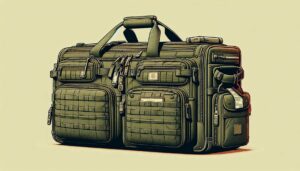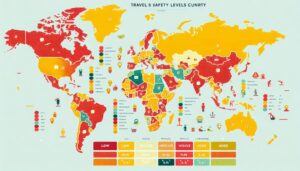Why Travel Watercolor Kits Are Trending
Travel watercolor kits have revolutionized the art world, allowing us to carry a mini studio wherever we go. Imagine sitting by Lake Toba, with a breathtaking view before you, and suddenly feeling the urge to capture the moment artistically. This is where your travel watercolor kit becomes a superhero!
Why is everyone suddenly buzzing about travel watercolor kits? The answers are simple:
- Maximum flexibility: Paint anytime, anywhere.
- Lightweight: No more shoulder aches from carrying full equipment.
- Spontaneity: Capture moments in a flash, no elaborate setup needed.
- Minimalist yet powerful: Create wow-worthy art with just a few tools.
Anatomy of an Ideal Travel Watercolor Kit
Palette: The Heart of Your Kit
Your palette isn’t just a paint container; it’s your creativity’s ‘kitchen’. Choose from:
- Pan palettes: Perfect for those who love neatness and color control.
- Tube palettes: For experimenters who enjoy unique color mixes.
- Dot palettes: Ultra-light solutions for true backpackers.
Pro tip: Select a palette with versatile colors. Usually, 12 colors are enough to create a myriad of combinations!
Brushes: The Artist’s Extended Hand
Travel brushes are just as sophisticated as their larger counterparts:
- Water brushes: 2-in-1, brush and water container. Super practical!
- Folding brushes: Compact but still high-quality.
- Mini brush sets: For those who like variety in size and shape.
Remember, it’s better to have one good brush than many mediocre ones.
Paper: Your Portable Canvas
The right paper can make or break your artwork:
- Watercolor postcards: Practical and can instantly become souvenirs.
- Watercolor-specific sketchbooks: For those who like neat documentation.
- Loose sheets: Flexible, perfect for those who like to frame their work.
Tip: Look for paper at least 300gsm to avoid buckling when wet.
Essential Accessories: Details That Make a Difference
Don’t underestimate these ‘small’ accessories:
- Sponge or tissue: For texture effects or absorbing excess water.
- Masking tape: Create neat borders or protect certain areas.
- Waterproof pen: For details or initial sketches.
Choosing a Travel Watercolor Kit: A Practical Guide

Ready-Made Kit vs. DIY: Which Suits You?
- Ready-made kits: Practical, ready to use. Suitable for beginners or those who prefer convenience.
- DIY kits: Flexible, can be customized to your needs. Ideal for those who know exactly what they need.
Budget-Friendly vs. High-End: The Right Investment
Remember, expensive doesn’t always mean better. Find what suits your needs and budget:
- Budget-friendly: Starting from around $20, you can get a decent basic kit.
- Mid-range: About $50-$100, you’ll get pretty good quality.
- High-end: Above $100, for those serious about their art and wanting top quality.
Size and Weight Considerations: Light as a Feather or Comprehensive as a Studio?
- Ultra-compact: Fits in your pocket, ideal for daily sketching.
- Medium-sized: Balanced between completeness and portability.
- Comprehensive kit: For dedicated painting trips, complete but still portable.
Expert Techniques for Using Travel Watercolor Kits
Quick Sketching: Capturing Essence in Minutes
- Focus on basic shapes and main lines.
- Use a dry brush for quick sketches.
- Add color sparingly, leave some white areas to ‘breathe’.
Layering on the Go: Techniques for Stunning Results
- Start with the lightest colors.
- Wait for each layer to dry before adding the next.
- Use a mini heat tool or travel hair dryer to speed up the drying process.
Mixing Colors: Tricks to Create an Unlimited Palette
- Make a mini color wheel in the corner of your paper for reference.
- Utilize wet-on-wet technique for smooth gradients.
- Experiment with mixing complementary colors for neutral tones.
Project Inspiration: From Beginner to Pro
Captivating Travel Journal
- Combine sketches with handwriting.
- Attach tickets or travel memorabilia as accents.
- Create interesting layouts with simple frames or borders.
Urban Sketching: Exploring Cities Through Painting
- Find strategic spots with interesting views.
- Focus on landmarks or unique architectural details.
- Add human figures to give scale and ‘life’.
Landscape Speedpainting: Chasing Light and Color
- Prepare several sheets for a series of quick paintings.
- Capture light changes in several short sessions.
- Use wet-on-wet technique for atmospheric effects.
Tales of Art Adventurers
From Mountains to Beaches: Experiences Painting in the Wild
Listen to Sarah’s story, a travel artist who has explored the archipelago:
“Once while painting sunrise at Mount Bromo, the wind was so strong my paper flew away. Since then, I always bring large paper clips. In Raja Ampat, the challenge was different. My paint dried super fast due to the heat. The solution? I brought a mini spray bottle to ‘water’ my palette occasionally.”
Unique Challenges and Creative Solutions
- Extreme weather: Bring a small umbrella or light raincoat.
- Limited time: Focus on painting 80% on location, finish 20% at your accommodation.
- Distractions from people around: Turn it into an opportunity to share and get new inspiration.
Maintaining Your Kit: Tips for Longevity and Ready Action
Effective Cleaning Routine
- Clean brushes immediately after use, don’t let paint dry on them.
- Wipe the palette with a damp tissue after finishing painting.
- Regularly check and clean palette lids to prevent mold.
Smart Storage for Long Life
- Store the kit in a cool, dry place.
- Use silica gel to absorb moisture.
- Separate paper from other components to prevent dampness.
Upgrades and Replacements: When Is It Time?
- Replace brushes when the bristles start falling out or change shape.
- Upgrade your palette when favorite colors run out or you want to explore new colors.
- Check the condition of your kit before each major trip to ensure everything is ready to use.
Community and Sources of Inspiration
Online Platforms for Sharing and Learning
- Instagram: Follow hashtags like #travelwatercolor or #watercolorjournal for daily inspiration.
- YouTube: Many tutorials and artist travel vlogs can serve as references.
- Urban Sketchers website: A global community with chapters in various cities.
Workshops and Retreats: Honing Skills with Experts
- Attend local workshops for basic techniques.
- Join painting retreats for the experience of painting while traveling.
- Organize sketchwalks with local communities to share tips and tricks.
Future Trends in Travel Watercolor

Material Innovations: What’s on the Horizon?
- Crayon-shaped watercolors: Practical and spill-proof.
- Extreme water-resistant watercolor paper: Paint even in the rain!
- Palettes with cooling technology: Prevent paint from drying quickly in hot weather.
Technology Integration: Painting in the Digital Era
- Color tracker apps: Scan surrounding colors to replicate in paintings.
- Digital watercolor stylus: Paint on tablets with the feel of real watercolors.
- AR (Augmented Reality) for previewing composition before starting to paint.
Conclusion: Painting Without Boundaries
A travel watercolor kit is more than just a painting tool. It’s a ticket to explore the world in a unique way, capturing moments in brush strokes and colors. With this tiny kit, every corner of the world can be an inspiration, and every journey is an opportunity to create.
So, are you ready to start your artistic adventure? Remember, you don’t need to be an expert to begin. The important thing is to dare to try, practice consistently, and always have fun! Let your travel watercolor kit be your faithful companion in every step of your world exploration. Happy painting and happy travels!
FAQ
- Q: What’s the difference between a travel watercolor kit and regular watercolor equipment?
A: Travel kits are more compact, lightweight, and specifically designed for high mobility. They usually include a mini palette, portable brushes, and easily carried accessories. - Q: What’s the minimum budget to start with a travel watercolor kit?
A: With a budget of about $30-$50, you can get a decent basic kit for beginners. But remember, investing in good quality will be more beneficial in the long run. - Q: How do I paint in crowded places without feeling awkward?
A: Start with less crowded places. Use earphones to focus, and remember that most people actually admire seeing the creative process. Consider it an opportunity to share your passion! - Q: Are there special techniques for quick painting while traveling?
A: Focus on main elements, use loose watercolor techniques, and don’t be afraid to simplify the scene. Practicing 5-10 minute quick sketching every day will greatly help hone this skill. - Q: How do I keep watercolors ‘workable’ in hot weather?
A: Bring a mini spray bottle to spritz the palette occasionally, choose shady spots, and consider bringing a palette with an airtight lid to maintain paint moisture.






